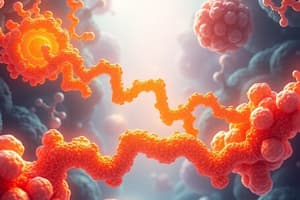Podcast
Questions and Answers
Which antibiotic is used to prevent TB in high-risk groups?
Which antibiotic is used to prevent TB in high-risk groups?
- Rifampin (correct)
- Quinolones
- Metronidazole
- Sulphonamides
What is the mechanism of action of Sulphonamides?
What is the mechanism of action of Sulphonamides?
- Inhibition of DNA synthesis
- Competitive inhibition of folic acid metabolism (correct)
- Inhibition of RNA synthesis
- Reduction of the nitro group
Which antibiotic is active against Gram-positive bacteria, including MRSA?
Which antibiotic is active against Gram-positive bacteria, including MRSA?
- Rifampin
- Quinolones
- Metronidazole
- Daptomycin (correct)
What is the indication for Nitrofurantoin (Uvamine Capsule)?
What is the indication for Nitrofurantoin (Uvamine Capsule)?
Which antibiotic is used to treat intestinal amebiases?
Which antibiotic is used to treat intestinal amebiases?
What is the target of Quinolones?
What is the target of Quinolones?
What is gentamicin administered for in central nervous system infections?
What is gentamicin administered for in central nervous system infections?
What is neomycin used to treat orally?
What is neomycin used to treat orally?
What is paromomycin used to treat?
What is paromomycin used to treat?
What is spectinomycin primarily used to target?
What is spectinomycin primarily used to target?
What is one of the primary uses of macrolides?
What is one of the primary uses of macrolides?
What is clindamycin used to treat in addition to acne vulgaris and bacterial vaginosis?
What is clindamycin used to treat in addition to acne vulgaris and bacterial vaginosis?
What is chloramphenicol used to treat?
What is chloramphenicol used to treat?
What is fusidic acid used to treat?
What is fusidic acid used to treat?
What is the common target of penicillins and cephalosporins?
What is the common target of penicillins and cephalosporins?
Which of the following cephalosporins has coverage against Pseudomonas aeruginosa?
Which of the following cephalosporins has coverage against Pseudomonas aeruginosa?
What is the indication for oral vancomycin?
What is the indication for oral vancomycin?
Which of the following is a fourth-generation cephalosporin?
Which of the following is a fourth-generation cephalosporin?
What is the mechanism of action of tetracyclines?
What is the mechanism of action of tetracyclines?
Which of the following aminoglycosides is active against Pseudomonas aeruginosa?
Which of the following aminoglycosides is active against Pseudomonas aeruginosa?
What is the usual form of administration for neomycin and tobramycin?
What is the usual form of administration for neomycin and tobramycin?
Which of the following antibiotic is a crucial last-reserve option for treatment of multidrug-resistant bacteria?
Which of the following antibiotic is a crucial last-reserve option for treatment of multidrug-resistant bacteria?
Study Notes
Inhibitors of Cell Wall Biosynthesis
- Penicillins:
- Benzylpenicillin (penicillin G) administered by injection
- Procaine benzylpenicillin reduces pain and discomfort when administered intramuscularly
- Benzathine penicillin is a long-acting penicillin injection
- Penicillin G is used to treat syphilis and rheumatic fever
- Cephalosporins:
- First-generation: Cefazolin for surgical prophylaxis
- Second-generation: Cefuroxime increases coverage against Haemophilus influenza
- Third-generation: Ceftriaxone or cefotaxime for meningitis, and Ceftazidime for Pseudomonas aeruginosa coverage
- Fourth-generation: Cefepime for meningitis and Pseudomonas aeruginosa coverage
- Fifth-generation: Ceftaroline for methicillin-resistant Staphylococcus aureus (MRSA)
- Glycopeptides:
- Vancomycin active against Gram-positive bacteria, MRSA, and Clostridium difficile
- Used for antibiotic-induced pseudomembranous colitis
Inhibitors of Cell Membrane Function
- Colistin is a last-reserve option for multidrug-resistant bacteria
Inhibitors of Protein Synthesis (30S Subunit Ribosome)
- Tetracyclines:
- Used for acne treatment
- Used for Upper Respiratory Tract Infections in penicillin-allergic patients
- Aminoglycosides:
- Neomycin and tobramycin for skin and eye infections
- Gentamicin active against Pseudomonas aeruginosa
- Streptomycin used for tuberculosis treatment
- Neomycin orally for hepatic encephalopathy
- Kanamycin as a second-line drug for tuberculosis
- Paromomycin for acute bacillary dysentery
- Spectinomycin active against Neisseria gonorrhea
Inhibitors of Protein Synthesis (50S Subunit Ribosome)
- Macrolides:
- Used for pneumonia, pharyngitis, and tonsillitis
- Clarithromycin for Helicobacter pylori infections
- Used for sexually transmitted infections and atypical pneumonia
- Used for Upper Respiratory Tract Infections in penicillin-allergic patients
- Lincosamides:
- Used for acne vulgaris and bacterial vaginosis
- Clindamycin for prophylactic coverage against endocarditis
- Used for anthrax and malaria
- Effective against MRSA in soft tissue infections
- Chloramphenicol:
- Used for eye and ear infections
- Alternative for meningitis and typhoid treatment
- Fusidic acid:
- Used for skin and eye bacterial infections
- Can be combined with steroids in creams
Inhibitors of Nucleic Acid Synthesis
- Inhibitors of DNA Synthesis:
- Quinolones: used for urinary tract infections
- Inhibitors of RNA Synthesis:
- Rifampin (Rifampicin):
- Active against Mycobacterium tuberculosis, Mycobacterium leprae, and Clostridium difficile
- Used prophylactically to prevent TB in high-risk groups
- Used alongside other drugs for TB treatment
- Rifampin (Rifampicin):
- Inhibitors of Folate Synthesis:
- Sulphonamides:
- Competitive inhibitors of folic acid metabolism
- Combination with trimethoprim for urinary tract infections and upper respiratory tract infections
- Sulphonamides:
Antibacterial Agents with Other Mechanisms
- Nitrofuran antibiotics:
- Nitrofurantoin (Uvamine Capsule) used for urinary tract infections
- Daptomycin:
- Active against Gram-positive bacteria, including MRSA
- Used for diabetic foot infections and prosthetic joint infections
- Metronidazole:
- Used for diarrhea due to intestinal amebiasis and bacterial vaginosis
Studying That Suits You
Use AI to generate personalized quizzes and flashcards to suit your learning preferences.
Description
This quiz covers the types of antibiotics that inhibit cell wall biosynthesis, including penicillins and cephalosporins, their uses and characteristics.




